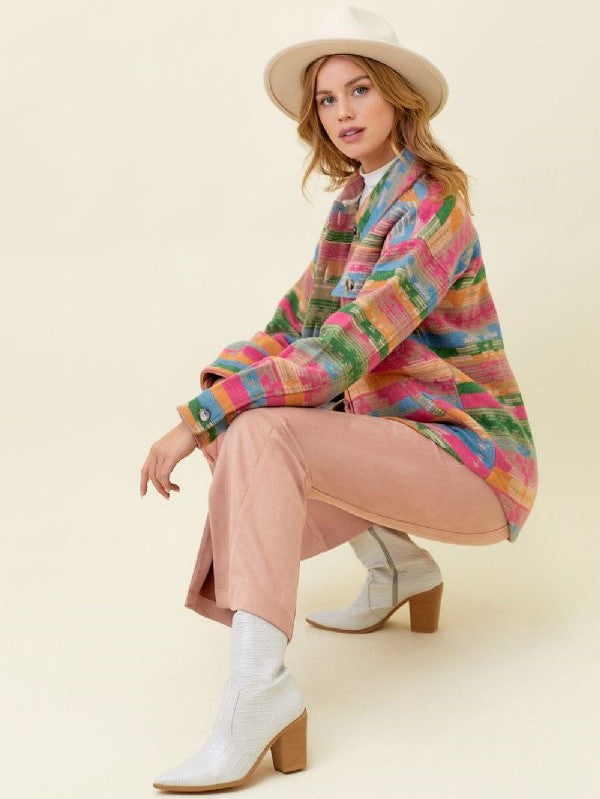The college budget frequently demands creative shopping approaches, with thrifting emerging as both an economic necessity and a sustainable fashion choice. However, building a cohesive wardrobe that incorporates both thrifted treasures and new purchases requires thoughtful strategy. When executed skillfully, this hybrid approach creates distinctive personal style while maximizing your fashion budget. This guide explores how to seamlessly integrate second-hand discoveries with strategic new purchases, creating a unique wardrobe that reflects both your personal aesthetic and practical needs.
Understanding the New-Thrifted Balance
Successful wardrobe building with mixed sources starts with understanding which pieces work best when purchased new versus thrifted. This strategic allocation maximizes both your budget and style impact.
New purchases like the Textured Collared Pocket Dress often make sense for foundation pieces that anchor your overall style. These "investment" items provide reliable quality and fit that complement more eclectic thrifted finds. The controlled variables of new purchases ensure you have dependable options for important occasions where experimentation might feel risky.
Meanwhile, thrift stores excel as sources for unique statement pieces, vintage finds, and items you might wear less frequently. Pairing a distinctive thrifted blazer with the Floral V-Neck Top with Scallop Trim creates a personalized look that balances reliability with individuality. This combination approach allows creative expression while maintaining functional wardrobe foundations.
Quality Assessment: Evaluating Second-Hand Potential
Developing the ability to quickly evaluate thrifted pieces for quality and potential dramatically improves your success rate when incorporating second-hand items into your wardrobe.
When thrifting, look for construction qualities similar to those found in Lush Lemon pieces like the Ruffle Tiered Midi Dress. Check seams for straight stitching, examine fabric composition for natural fibers when possible, and assess overall construction quality. These fundamentals determine whether an item will successfully integrate with your higher-quality new purchases.
Consider potential alterations when evaluating thrifted finds. A vintage dress with outdated proportions might pair beautifully with the Contrast Satin Trim Mini Dress after simple hemming or sleeve adjustments. This alteration perspective often reveals hidden potential in second-hand pieces that others might overlook.
The Bridge Piece Concept: Creating Cohesion
The most successful thrifted-new combinations often incorporate "bridge pieces" that facilitate cohesion between different sourcing categories. These items share elements with both your thrifted finds and new purchases, creating visual connections across your wardrobe.
The Floral Embroidered Lace Top with Fringe Detail exemplifies a perfect bridge piece. Its bohemian elements complement vintage thrifted items while its contemporary construction aligns with new purchases. This dual compatibility allows it to function as a connector between different sourcing categories in your wardrobe.
Similarly, accessories like the Letter Of Mine Necklace often serve as ideal bridges between thrifted and new components. Their versatile nature allows them to complement both categories while adding personal significance to your overall look. These connecting elements transform what might otherwise appear as disparate pieces into a cohesive personal collection.
Style Anchoring: Using New Pieces as Foundations
New purchases often serve most effectively as style anchors—reliable foundation pieces that provide structure for more experimental thrifted additions. These anchoring elements ensure your overall look maintains cohesion regardless of how unique your thrifted components might be.
The High Waist Angled Side Seam Detail Flare from Judy Blue represents a perfect anchoring piece. Their consistent fit and contemporary silhouette create a reliable foundation for pairing with more variable thrifted tops or jackets. This stability allows greater freedom in your thrifted selections without risking overall outfit cohesion.
For dressier occasions, the Santorini Coastal Sketch Short Dress provides an anchoring element that can be personalized with thrifted accessories or layers. Its quality construction and thoughtful design create a reliable foundation that supports creative expression through complementary second-hand additions.
Color Coordination Across Sources
Developing a cohesive color strategy across both thrifted and new items creates natural harmony regardless of where individual pieces originated. This approach provides a visual throughline that ties your mixed-source wardrobe together.
Consider using the color palette from a new purchase like the Garden Reverie Maxi Dress as a reference guide when thrifting. The established colors in this piece can inform which second-hand items will naturally integrate with your existing wardrobe, creating intuitive coordination without requiring exact matches.
Alternatively, build around versatile neutrals like those found in the Contrast Collar Knit Polo Mini Dress, then introduce color through thrifted accessories or accent pieces. This foundation approach provides flexibility while maintaining overall cohesion, allowing unique thrifted finds to become focal points within a structured framework.
Era Mixing: Contemporary Context for Vintage Finds
Incorporating vintage thrifted pieces into a contemporary wardrobe requires thoughtful contextualization to avoid appearing costumey or disconnected from current aesthetics. Strategic pairing with modern elements creates fresh interpretations of timeless styles.
A vintage thrifted blouse might pair beautifully with the High Waist Double Cuff Shorts from Judy Blue, creating a balanced combination of nostalgia and contemporary style. This juxtaposition often produces the most interesting outfits—neither fully vintage nor completely current, but a unique personal interpretation that transcends either category.
Similarly, pairing a thrifted vintage dress with modern accessories from Lush Lemon creates contextual updating that honors the original piece while making it relevant to contemporary settings. This balanced approach respects the history of vintage items while integrating them naturally into your current lifestyle.
Texture Conversations: Creating Dimensional Interest
One of the most effective strategies for combining thrifted and new items involves creating intentional texture contrasts that add visual interest and dimension to your outfits. These textural conversations create cohesion through thoughtful opposition rather than similarity.
The Embroidered Puff Sleeve Pullover Top with Pleated Collar might pair beautifully with a more structured thrifted skirt, creating interest through textural contrast. The interplay between different fabric weights, structures, and finishes often produces more sophisticated outfits than those relying solely on color or style coordination.
Similarly, the smooth finish of the Zip Front Drawstring Waist Mini Dress provides a perfect canvas for showcasing more textured thrifted accessories like vintage brooches or textured handbags. This balanced approach ensures neither source dominates visually while creating rich dimensional interest in your overall look.
The 70/30 Approach: Strategic Wardrobe Building
Many successful hybrid wardrobe builders follow a rough 70/30 ratio between foundational pieces and more distinctive accent items. This balance ensures sufficient reliability while allowing personal expression through unique finds.
Consider allocating approximately 70% of your wardrobe budget to quality new foundation pieces like the Embroidered Ruffle Tie Back Dress that serve regular rotation needs. These reliable items provide the framework within which your more expressive thrifted pieces (approximately 30% of your collection) can shine without overwhelming your overall style identity.
This proportional approach allows calculated risk-taking with thrifted pieces while maintaining wardrobe functionality. The foundation pieces ensure you always have appropriate options for important occasions, while the thrifted components add personality and distinction to your everyday looks.
The Upgrade Path: Replacing Thrifted with New
As your fashion budget evolves throughout your college years, developing a thoughtful upgrade strategy allows gradual transition from predominantly thrifted to more intentionally purchased pieces without sacrificing the uniqueness of your established style.
Begin by identifying which thrifted pieces serve essential functions in your wardrobe but show quality limitations. These become natural candidates for replacement with new versions like the Aegean Garden Flutter Sleeve Dress that provide similar aesthetic contributions with superior construction and longevity.
Conversely, some thrifted pieces may prove irreplaceable due to their unique vintage characteristics or perfect alignment with your personal style. These keepers deserve complementary new purchases that enhance their special qualities rather than replacement. For these pairings, new additions like the Daphne Open Hoop Earring serve to highlight rather than overshadow your cherished thrifted finds.
Seasonal Integration: Weather-Appropriate Combinations
Successful thrifted-new wardrobes require thoughtful seasonal integration that accounts for both style cohesion and practical weather considerations throughout the academic year.
For fall transitions, the Ribbed Knit Mock Neck Sweater provides a perfect new-purchase layer over thrifted summer dresses, extending their wearability into cooler weather. This layering approach maximizes the utility of your thrifted finds while ensuring weather-appropriate comfort through strategic new additions.
Similarly, new-purchase lightweight layers like those from Lush Lemon's jacket collection can transform thrifted winter pieces for spring wear. This seasonal adaptability through strategic layering ensures your thrifted components remain relevant year-round rather than being relegated to specific weather conditions.
Alterations as Integration Tools: Customizing for Cohesion
Simple alterations often provide the missing link between thrifted finds and your carefully selected new purchases, transforming good potential into perfect integration.
Consider how hemming a thrifted skirt to complement the proportions of the Smocking Detailed Woven Shirt might create a perfectly balanced outfit. These minor adjustments often require minimal investment while dramatically increasing the wearability and integration potential of thrifted pieces.
Similarly, replacing dated buttons on a thrifted blazer with contemporary options that complement your new purchases can modernize vintage finds without sacrificing their unique character. These small customizations create visual continuity between different sourcing categories while preserving the special qualities that attracted you to the thrifted pieces initially.
The Authenticity Factor: Personal Curation Across Sources
Perhaps the most compelling hybrid wardrobes emerge from authentic personal curation rather than rigid sourcing rules. This approach focuses on building a collection that reflects your genuine preferences regardless of where individual pieces originated.
The Floral Eyelet Short Sleeve Mini Dress might align perfectly with your aesthetic whether you discovered it new at Lush Lemon or as a fortunate thrift store find. This style authenticity—selecting pieces that truly resonate with your personal preferences across any sourcing category—creates the most natural wardrobe cohesion regardless of price points or origins.
This authentic curation approach often yields signature looks that become associated with your personal style. The combination of thoughtfully selected new pieces with distinctive thrifted finds creates outfits that feel uniquely yours rather than trending or mass-produced, regardless of the actual sources involved.
Sustainable Partnership: Environmental Benefits
Beyond budget considerations, the partnership between thrifted and new purchases offers significant sustainability benefits worth acknowledging in your fashion approach.
Each thrifted piece integrated into your wardrobe represents resources conserved and waste diverted. Pairing these second-life items with thoughtfully selected, quality new purchases like the Print Satin Tiered Mini Dress creates an environmentally conscious approach that balances sustainability with contemporary style needs.
Consider prioritizing new purchases from brands demonstrating ethical production values, further enhancing the overall sustainability of your hybrid wardrobe approach. This conscientious partnership between mindful new acquisitions and repurposed thrifted items aligns personal style development with broader environmental values.
Final Thoughts: Your Uniquely Curated Collection
The most successful thrifted-new wardrobes ultimately reflect your personal journey, combining budget-conscious practicality with authentic style expression. This hybrid approach often yields the most interesting wardrobes—neither wholly driven by current trends nor completely dependent on chance thrift discoveries.
The Lush Lemon collection offers pieces specifically designed to complement thrifted finds while providing the quality and contemporary relevance needed for foundation wardrobe elements. From structured basics to special-detail pieces, these thoughtfully created items support your thrifting adventures without limiting your creative expression.
Visit Lush Lemon to explore their collection of thrift-complementary fashion that balances contemporary style with the versatility needed to pair with your unique second-hand discoveries. With strategic selection and thoughtful integration, you'll develop a wardrobe that maximizes both your budget and personal style expression throughout your college years and beyond.





